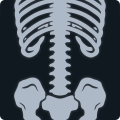Types of DXA scans
Although DXA has the capacity to carry out many scan types, its main two areas cover bone mineral density and body composition analysis.
Bone Mineral Density (BMD):
The aim of BMD scanning is to test how dense a person’s bones are which can provide information on your risk of conditions such as osteoporosis. A routine procedure takes around 15 minutes and can include the following sites:
 Lumbar (lower) spine
Lumbar (lower) spine Hip
Hip Forearm
Forearm
Body Composition Analysis (BCA):
BCA scanning uses an image of the whole body to differentiate bone, fat and muscle tissue. The information which can be gained from this method can be used to assess a person’s risk of various obesity and metabolic related conditions as well as to monitor progress of treatment plans which may aim to manipulate bone, fat or muscle mass from either a whole body or regional perspective. The procedure takes between 3 and 7 minutes.

BCA is used to assess risk of obesity and other metabolic conditions & to monitor progress of treatment
Learn More:
Find your nearest DXA Clinic
DXA Clinic Finder

